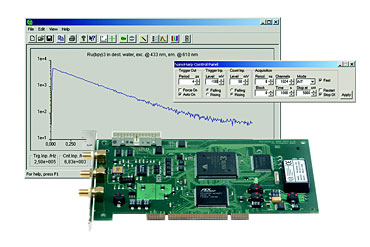
Developer's Library Software Version 2.1
PicoQuant GmbHRequest Info
For NanoHarp 250's PCI Board Used in Multichannel Scaling, Photon Counting
A new Developer's Library software release is available from PicoQuant
GmbH for the NanoHarp 250 data acquisition board to be used
in multichannel scaling and photon counting.
The NanoHarp
250 is a short PCI slot card with integrated input discriminators and
is an ideal instrument for the acquisition of fluorescence/luminescence
decays on the nanosecond to millisecond time scale, PicoQuant said.
Other applications include optical time-domain reflectometry (OTDR),
time-of-flight mass spectrometry and range finding.
The new
Developer's Library software version 2.1 now extends the capabilities
of the board by making the programmable trigger output more flexible.
Excitation sources such as the PDL 800-B diode laser family can now be
triggered only if a measurement is running to avoid bleaching of
fluorophores.
The software runs on all recent Windows
platforms, including Windows ME, 2000 and XP. Data can be collected and
visualized online. An intuitive and clean graphical user interface with
 comprehensive
online help guarantees a short learning curve. The new software also
supports control for an extended range of monochromators, permitting
the automated recording of time-resolved emission spectra. Fluorescence
decay analysis is facilitated by direct transfer to the popular FluoFit
software. A new programming library, including a rich set of example
programs, is separately available to support the development of custom
software and to aid integration with existing automated instruments,
e.g. under LabView, PicoQuant said.
comprehensive
online help guarantees a short learning curve. The new software also
supports control for an extended range of monochromators, permitting
the automated recording of time-resolved emission spectra. Fluorescence
decay analysis is facilitated by direct transfer to the popular FluoFit
software. A new programming library, including a rich set of example
programs, is separately available to support the development of custom
software and to aid integration with existing automated instruments,
e.g. under LabView, PicoQuant said.
By means of
reconfiguration of the board's programmable logic, the software
provides two different measurement modes. For high resolution
measurements, the fast mode provides a time bin resolution of 4 ns. In
slow mode, the time bin width is 32 ns. This extends the usable time
span of the decay or OTDR measurement to over two seconds. In both
modes, up to 262144 time bins are available.
The board's
multistop capability allows efficient recording of long-lived
fluorescence decays with correspondingly slow excitation rates, the
company said. On-board histogram memory is 18-bits deep, allowing the
collection of 262144 counts per bin without software intervention.
Software adjustable discriminators and on-board polarity switches allow
the NanoHarp 250 to be interfaced to a wide range of signal and trigger
sources, including all common single-photon detectors such as
photomultiplier tubes and single-photon avalanche photodiodes. Count
rates up to 50 MHz can be processed; histogram data is efficiently
transferred by means of bus-mastering DMA.
PicoQuant develops
electro-optical instrumentation and systems, picosecond diode lasers
and time-resolved fluorescence systems. For more information, visit: www.picoquant.com ; e-mail: [email protected]PicoQuant GmbH
Rudower Chaussee 29
12489 Berlin, Germany
Phone: (49-30) 6392-6560
Fax: (49-30) 6392-6561
https://www.picoquant.com
/Buyers_Guide/PicoQuant_GmbH/c11829
Published: June 2006
REQUEST INFO ABOUT THIS PRODUCT
* First Name:
* Last Name:
* Email Address:
* Company:
* Country:
Message:
When you click "Send Request", we will record and send your personal contact information to PicoQuant GmbH by email so they may respond directly. You also agree that Photonics Media may contact you with information related to this inquiry, and that you have read and accept our
Privacy Policy and
Terms and Conditions of Use.
Register or login to auto-populate this form:
Login
Register
* Required